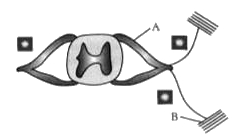Explain the addition and substitution reaction with the help of examples. C2H6 undergoes substitution reaction but not addition reaction. Why?Solution in Kannada
Substitution reaction : Those reactions in which an atom or group of atoms of a compound are replaced by other atom or group of atoms are called substitution reactions.
CH4methane+Cl2chlorine sunlight −−−−−−−−→CH3Clchloromethane+HCIhydrogen chloride
Addition reaction : Those reactions in which two or more molecules or compounds are combined to form a large molecule or compounds, are called addition reaction. lt takes place in unsaturated hydrocarbon
CH2=CH2+H2−−→NiC2H6
Presence of multiple bonds (double and triple bonds) between carbon atoms in the chain of hydrocarbon is one of the essential condition for addition reaction.
As ethane has no double or triple bond, it does not undergo addition reaction, rather it goes for substitution reaction.
OR
Cleansing Action of Soap : A soap molecule consists of two dissimilar parts :
(i) A short ionic part comprising the carboxylate salt -COO−Na+ which is water soluble.
(ii) A long hydrocarbon chain which is hydrophobic.
When soap is dissolved in water, it forms a colloidal suspension. In this colloidal suspension, the soap molecules duster together to form micelles and remain radially suspended in water with the hydrocarbon end towards the centre and the ionic end directed outward. The dirt particles always adhere to the oily or greasy layer present on the skin or clothes. When a dirty doth is dipped into a soap solution, its nun-polar hydrocarbon end of micelles gets attached to the grease or oil present in dirt and polar end rema.ins in water layer.
The mechanical action of rubbing subsequently, dislodges the oily layer from the dirty surface shaping it into small globules. A stable emulsion of oil in water is formed. The emulsified oil or grease globules bearing the dirt can now be readily washed with water.
(ii) In hard water, soap reacts with calcium and magnesium salts which are present in hard water and form insoluble substances called scum. Thus scum is insoluble and floats on the surface of water.
When soap is shaken with hard water, which contains Ca+2andMg+2 ions, very less lather is formed and thus cleaning of clothes equire more soap.
Topper's Solved these Questions
- SSLC KARNATAKA JUNE 2020 CLASS -X Book:OSWAAL PUBLICATIONChapter:SSLC KARNATAKA JUNE 2020 CLASS -X Exercise:V. ANSWER THE FOLLOWING QUESTIONS
Explore 4 Videos
- SSLC KARNATAKA JUNE 2020 CLASS -X Book:OSWAAL PUBLICATIONChapter:SSLC KARNATAKA JUNE 2020 CLASS -X Exercise:VI. ANSWER THE FOLLOWING QUESTION
Explore 1 Video
- SSLC KARNATAKA JUNE 2020 CLASS -X Book:OSWAAL PUBLICATIONChapter:SSLC KARNATAKA JUNE 2020 CLASS -X Exercise:III. ANSWER THE FOLLOWING QUESTIONS
Explore 8 Videos
- SOLVED PAPER SSLC KARNATAKA APRIL 2019 Book:OSWAAL PUBLICATIONChapter:SOLVED PAPER SSLC KARNATAKA APRIL 2019 Exercise:QUESTIONS
Explore 49 Videos
Similar Questions
Name the given structure. What is its general function ? Mention the function of the parts labelled as A and B. These structures in animals are said to be more efficient to give quick responses. Why ?

View SolutionExplain the experiment conducted by Newton to show that white light contains seven colours. Sun appears red in colour during sunrise but appears white at noon. Explain with the reasons.
View SolutionAgricultural scientists have suggested to add a certain amount of lime powder to an agricultural field. What may be the reason for this ? Explain.
View SolutionThe change that occurs in the eye to see the distant object clearly is
View SolutionWhy do alkenes prefer to undergo electrophilec addition reaction while arenes prefer electrophilic substitution reactions ? Explain.
View SolutionWhy do alkenes prefer to undergo electrophilec addition reaction while arenes prefer electrophilic substitution reactions ? Explain.
View SolutionExplain with an example.
View Solutionयोगात्मक अभिक्रिया तथा प्रतिस्थापन अभिक्रिया को एक - एक उदाहरण देकर समझाए।
View SolutionWhy ,benzene undergoes substitution reaction more readily than addition reaction ?
View SolutionWhy benzene undergoes electrophillic substitution reaction where as alpenses undergoes addition reaction?
View SolutionWhy benezene undergoes substitutions reaction rather than addition reaction under normal conditions
View SolutionWhy does benzene undergo electrophilic substitution reaction instead of electrophilic addition reaction ? Discuss the mechanism of chlorination of benzene,
View SolutionIntroduction to Substitution Reaction | Addition Reaction | Elimination Reaction
View SolutionDifferentiate between addition reaction and substitution reaction.
View SolutionExplain the addition and substitution reaction with the help of examples. C2H6 undergoes substitution reaction but not addition reaction. Why?
View Solution